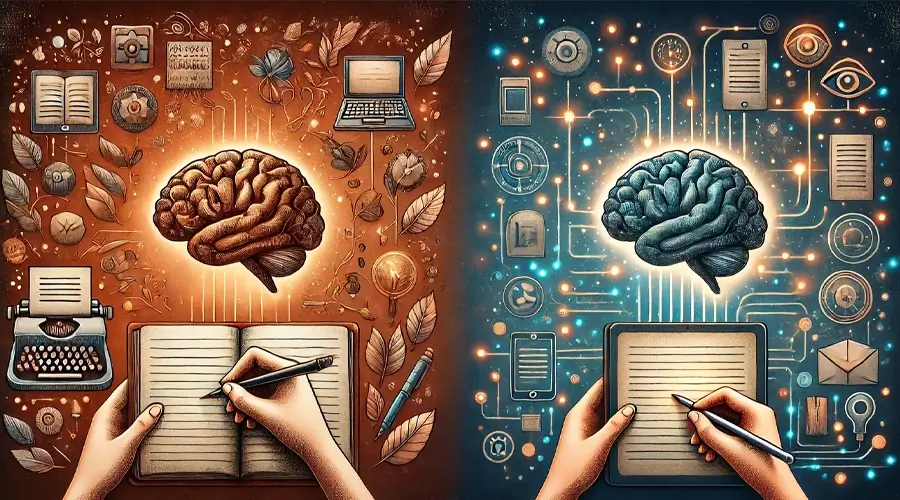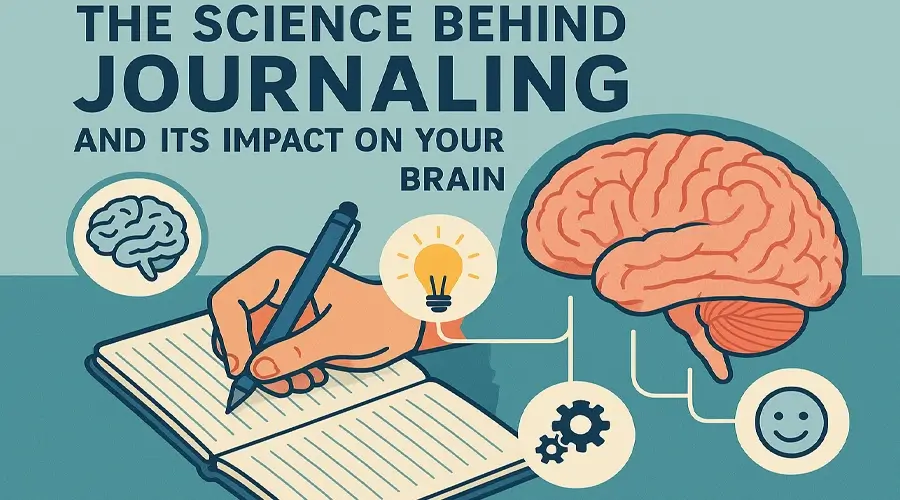In a world overwhelmed by digital distractions and fast-paced living, journaling has emerged as a powerful tool for self-reflection, stress relief, and mental clarity. What was once considered a simple act of keeping a diary has now gained recognition in neuroscience as a practice that profoundly influences brain function. But why does writing our thoughts down feel so therapeutic? The answer lies in the intricate workings of the brain. When you put pen to paper, you’re not just documenting your day—you’re engaging in a process that activates key areas of your brain, from the prefrontal cortex (responsible for rational thinking and decision-making) to the limbic system (which regulates emotions). Research shows that journaling rewires neural pathways, enhances neuroplasticity, and can even help reduce overactivity in the amygdala, the brain’s fear and stress center. In this article, we’ll explore the fascinating neuroscience of journaling, unveiling how this simple habit can reshape the way you think, feel, and process the world around you.
The Neuroscience of Journaling: How Your Brain Responds
Journaling is more than just a means of self-expression—it’s a cognitive workout that actively engages and reshapes your brain. When you sit down to write, a cascade of neural processes is triggered, influencing how you think, regulate emotions, and respond to stress. From activating the prefrontal cortex to calming the amygdala, the act of journaling is deeply intertwined with neuroplasticity, allowing your brain to adapt and grow in response to your thoughts and experiences.

The Prefrontal Cortex: Enhancing Cognitive Processing
The prefrontal cortex (PFC) is the brain’s executive command center, responsible for decision-making, logical reasoning, and problem-solving. When you write in a journal, this area is activated, helping you process complex emotions and organize your thoughts. Unlike passive thinking, writing forces the brain to slow down, analyze situations, and articulate ideas clearly. This structured form of self-expression strengthens the neural pathways associated with cognitive control, allowing for better focus, improved emotional intelligence, and enhanced decision-making skills. Over time, consistent journaling can increase metacognition, the ability to think about one’s own thinking, leading to greater self-awareness and personal growth.
The Amygdala: Processing Emotions and Reducing Stress
At the core of our emotional responses lies the amygdala, the brain’s alarm system responsible for processing fear, stress, and emotional intensity. When we experience strong emotions but don’t process them, the amygdala can become overactive, leading to heightened anxiety and stress. Expressive writing, a form of journaling where individuals explore deep thoughts and feelings, has been scientifically proven to calm the amygdala’s activity. Studies show that putting emotions into words, a process called affect labeling, reduces emotional distress and allows the prefrontal cortex to regain control over the brain’s emotional response. This is why journaling often provides an immediate sense of relief—it helps translate overwhelming emotions into structured thoughts, making them easier to manage.
Neuroplasticity: How Journaling Rewires Your Brain for Emotional Regulation
One of the most remarkable aspects of journaling is its ability to rewire the brain through neuroplasticity—the brain’s capacity to form and strengthen new neural connections. When you repeatedly engage in journaling, especially focusing on gratitude, self-reflection, or positive affirmations, you reinforce positive thinking patterns. Over time, this strengthens the neural pathways associated with resilience, emotional regulation, and optimism. This means that journaling isn’t just about processing past experiences; it actively shapes how your brain responds to future challenges. Regular journaling has been linked to reduced symptoms of depression and anxiety, improved emotional stability, and a more adaptive mindset.
By engaging multiple brain regions, from the prefrontal cortex to the limbic system, journaling acts as a natural cognitive therapy, helping you make sense of your thoughts while improving emotional balance. The next time you pick up a pen to write, remember—you’re not just documenting your experiences; you’re rewiring your brain for clarity, resilience, and growth.
Journaling and Emotional Well-being: A Brain-Based Perspective
Journaling is often viewed as a personal habit, but its effects go far beyond simple self-expression—it has a profound impact on emotional well-being at a neurological level. Writing about emotions activates the limbic system, the brain’s emotional processing center, allowing for deeper self-awareness and emotional regulation. Unlike rumination, where negative thoughts loop endlessly in the mind, structured writing provides clarity, helping individuals break free from harmful thought patterns. Neuroscientific research supports the power of expressive writing in reducing stress and anxiety, making journaling a scientifically backed tool for emotional resilience and mental well-being.
How Writing About Emotions Activates the Limbic System
The limbic system, particularly the amygdala and hippocampus, plays a crucial role in processing emotions and memories. When you experience intense emotions, the amygdala—the brain’s fear and stress center—can become hyperactive, leading to anxiety, stress, or even emotional overwhelm. However, when you write about your emotions, you engage the prefrontal cortex, which helps regulate the amygdala’s response. This process, known as affect labeling, allows you to make sense of your emotions rather than being consumed by them.
Additionally, writing stimulates the hippocampus, the brain’s memory center, helping integrate emotional experiences into a structured narrative. This is why journaling about a difficult situation often brings a sense of relief—it allows the brain to process emotions more effectively, reducing their intensity over time.

The Impact of Expressive Writing on Reducing Stress and Anxiety
Scientific studies have shown that expressive writing, where individuals freely explore their thoughts and emotions on paper, has a direct impact on stress reduction and anxiety management. When people write about traumatic or stressful experiences, they experience lower levels of cortisol, the body’s primary stress hormone. This suggests that journaling acts as a natural emotional detox, preventing negative emotions from building up and manifesting as anxiety or depression.
One reason for this is that writing creates a sense of psychological distance from distressing emotions. Instead of being trapped in overwhelming thoughts, journaling allows you to externalize them, making them more manageable. Research also indicates that individuals who engage in regular journaling tend to have lower blood pressure, improved immune function, and better overall mental health—a testament to the profound mind-body connection facilitated by writing.
Journaling vs. Rumination: How Structured Writing Helps Break Negative Thought Cycles
One of the biggest emotional pitfalls people face is rumination, the repetitive overthinking of negative experiences or worries. When left unchecked, rumination can contribute to anxiety, depression, and a sense of helplessness. However, journaling offers a structured way to process thoughts, helping individuals shift from passive dwelling to active problem-solving.
Unlike rumination, where the brain replays distressing thoughts without resolution, journaling encourages a more constructive approach by:
- Organizing chaotic emotions into coherent narratives.
- Identifying patterns and triggers behind stress and anxiety.
- Offering a safe space for self-reflection and cognitive restructuring.
By transitioning from passive worry to active reflection, journaling rewires the brain to adopt a more solution-oriented mindset. Techniques like gratitude journaling, cognitive reframing, and goal-setting journals further reinforce positive thinking patterns, reducing the likelihood of getting stuck in negative loops.
Journaling isn’t just a means of self-expression—it’s a neuroscience-backed tool for emotional well-being. By engaging the limbic system, reducing amygdala overactivity, and breaking cycles of rumination, journaling empowers individuals to navigate emotions with greater clarity and resilience. If practiced consistently, it becomes more than just writing—it becomes a form of mental self-care, shaping a healthier and more balanced mind.
How to Journal Effectively Based on Neuroscience
Journaling is a powerful tool for mental clarity, emotional regulation, and cognitive growth, but like any habit, its effectiveness depends on how you approach it. Neuroscience shows that different journaling techniques engage distinct areas of the brain, each serving a unique purpose in processing emotions, enhancing self-awareness, and improving decision-making. To maximize the benefits, it’s essential to adopt best practices backed by research. Whether you’re aiming to gain insight into your emotions, set clear goals, or simply declutter your mind, the key is consistency over perfection.
Best Practices: Structured Journaling, Stream-of-Consciousness Writing, and Gratitude Logs
There’s no single “right” way to journal, but neuroscience suggests that certain methods activate different cognitive processes, each offering unique benefits:
1. Structured Journaling: Organizing Your Thoughts for Clarity
- Engages the prefrontal cortex, strengthening logical thinking and problem-solving.
- Helps break down complex emotions into manageable insights.
- Best for: Analyzing patterns, tracking progress, and making informed decisions.
- Example format:
- What happened today? (Objective recounting)
- How did it make me feel? (Emotional processing)
- What did I learn from this? (Cognitive restructuring)
- What actions will I take? (Future planning)
2. Stream-of-Consciousness Writing: Releasing Mental Clutter
- Activates the default mode network (DMN), which enhances creativity and self-reflection.
- Bypasses the prefrontal cortex’s filtering, allowing raw emotions and ideas to surface.
- Helps reduce amygdala overactivity, making it an effective tool for stress relief.
- Best for: Emotional detox, creative exploration, and discovering subconscious thoughts.
- Example technique: Morning Pages (writing freely for 10–15 minutes without stopping).
3. Gratitude Journaling: Rewiring the Brain for Positivity
- Strengthens neural pathways associated with positive emotions and resilience.
- Shifts focus from problems to solutions, reducing stress and boosting mood.
- Increases dopamine and serotonin levels, improving overall emotional well-being.
- Best for: Enhancing optimism, reducing negativity bias, and building emotional resilience.
- Example format:
- Three things I’m grateful for today.
- One positive experience I had.
- One challenge I overcame.
How to Leverage Journaling for Mental Clarity, Self-Awareness, and Goal Setting
Journaling isn’t just about reflection—it’s also a tool for shaping your future. Here’s how different approaches help:
- For mental clarity: Use brain dumps—write freely about everything on your mind to declutter thoughts and reduce overwhelm.
- For self-awareness: Practice emotional tracking, writing about how different situations make you feel and why. This helps recognize patterns in thoughts and behaviors.
- For goal setting: Write about where you want to be in six months or a year, and break down actionable steps to get there. Studies show that writing down goals increases the likelihood of achieving them by activating the reticular activating system (RAS), the brain’s filtering mechanism for prioritizing important information.

The Importance of Consistency Over Perfection
One of the biggest mistakes people make with journaling is overcomplicating it. Neuroscience suggests that frequency matters more than length or complexity. A few lines written consistently have a greater impact than sporadic deep dives.
- Journaling strengthens neural connections over time—even five minutes a day is enough to reshape thought patterns.
- Perfectionism can kill the habit—allow yourself to write imperfectly, without worrying about grammar or structure.
- The goal is reflection, not documentation—it’s about processing emotions, not creating a literary masterpiece.
Journaling, when done with intention and consistency, is a brain-enhancing habit that fosters emotional intelligence, cognitive flexibility, and resilience. Whether you prefer structured prompts, free writing, or gratitude logs, the key is to integrate journaling into your routine in a way that feels natural. Over time, you’ll not only see improvements in mental clarity and self-awareness, but also in your ability to regulate emotions, set goals, and navigate life’s challenges with greater confidence.
The Science of Handwriting vs. Digital Journaling
The debate between handwriting and digital journaling isn’t just about personal preference—it has deep roots in neuroscience. While both methods offer cognitive and emotional benefits, research suggests that handwriting engages the brain in a fundamentally different way than typing. The sensorimotor engagement of handwriting enhances memory and comprehension, while digital journaling provides convenience and habit-tracking benefits. Understanding the neuroscience behind each approach can help you choose the journaling method that best aligns with your goals.
How Handwriting Engages Sensorimotor Areas More Than Typing
Handwriting is a multisensory process that requires complex coordination between the brain, hand, and visual system. Unlike typing, which involves pressing uniform keys, handwriting demands unique motor movements for each letter. This engages the sensorimotor cortex, the area responsible for fine motor skills, and strengthens neural pathways related to learning and cognitive processing.
Key differences between handwriting and typing include:
- Deeper neural encoding: Writing by hand activates the reticular activating system (RAS), which helps filter and prioritize important information. This means handwritten notes are often remembered more effectively than typed ones.
- Stronger conceptual understanding: Studies show that people who write by hand process information more deeply than those who type, making it ideal for self-reflection, emotional processing, and goal setting.
- Reduced distractions: Unlike digital platforms, which come with notifications and multitasking temptations, handwriting provides a focused, immersive experience that enhances mindfulness.

The Role of Kinesthetic Learning in Boosting Comprehension and Recall
Kinesthetic learning refers to the process of understanding information through physical movement. When you write by hand, you create a kinesthetic memory of words and concepts, reinforcing retention. This is particularly important for:
- Memory consolidation: The hippocampus, responsible for memory formation, strengthens connections when handwriting is involved.
- Emotional processing: Because handwriting slows down cognitive processing, it allows for deeper emotional reflection compared to fast typing.
- Creativity and idea generation: Free-flowing handwriting engages the default mode network (DMN), which is responsible for creative problem-solving and self-reflection.
This is why many creatives, writers, and thinkers prefer handwriting their initial thoughts—it provides a deeper mental connection to ideas and enhances long-term recall.
Digital Journaling and Its Advantages in Habit-Building and Tracking Patterns
While handwriting has strong neurological benefits, digital journaling comes with advantages that can’t be ignored. Modern tools provide structured ways to track emotions, identify patterns, and build consistency, making journaling more accessible and sustainable.
Some of the key benefits of digital journaling include:
- Ease of habit formation: Digital platforms like Notion, Day One, and Evernote provide reminders and templates that make journaling a consistent practice.
- Searchability and organization: Unlike handwritten journals, digital entries are easy to search, categorize, and revisit, allowing for pattern recognition over time.
- Data-driven self-awareness: Many apps now include mood-tracking and AI-assisted insights, helping users identify behavioral trends.
- Accessibility and security: Digital journaling offers cloud backups and password protection, ensuring privacy while allowing multi-device access.
However, digital journaling can come with distractions and reduced cognitive engagement, which is why some people prefer a hybrid approach—handwriting for deep reflection and digital journaling for habit-tracking and organization.
Both handwriting and digital journaling have unique benefits, and choosing the right method depends on your goals. If you want deeper cognitive processing, enhanced creativity, and emotional connection, handwriting is ideal. On the other hand, if you prioritize habit-building, pattern tracking, and convenience, digital journaling offers powerful tools to stay consistent.
Conclusion
In this article, we explored the neuroscience of journaling and how it profoundly impacts the brain. Far from being just a habit of self-expression, journaling activates key brain regions like the prefrontal cortex, amygdala, limbic system, and hippocampus, shaping the way we think, feel, and process experiences. By engaging in structured writing, we enhance cognitive processing and decision-making, while expressive writing helps regulate emotions by calming the amygdala and reducing stress.
We also examined the power of neuroplasticity, which allows journaling to rewire the brain for greater emotional resilience and mental clarity. Techniques like structured journaling, stream-of-consciousness writing, and gratitude logging offer unique cognitive benefits, from improving self-awareness and memory to fostering a positive mindset and reducing anxiety. Furthermore, the science behind journaling vs. rumination highlights why writing helps break negative thought cycles, promoting constructive problem-solving instead of emotional looping.
Download Verbo AI APK now — your intelligent journaling partner is here.
Capture thoughts, track growth, and reflect smarter, every day.



